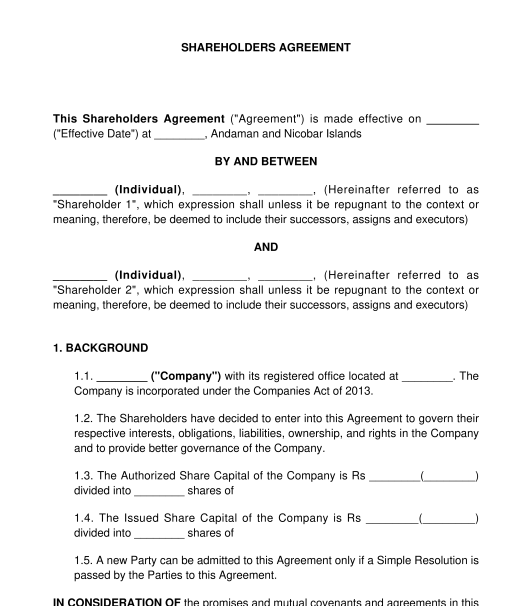 13-09-2025
13-09-2025

Answer a few questions and your document is created automatically.

Your document is ready! You will receive it in Word and PDF formats. You will be able to modify it.

 13-09-2025
13-09-2025
 Word and PDF
Word and PDF
 13 to 20 pages
13 to 20 pages



A Shareholders Agreement is a crucial legal document that is designed to safeguard the rights and interests of the shareholders within a company. This agreement is legally binding and applies only to the parties involved, creating a formal contractual relationship between them. The goal of a Shareholder Agreement is to provide a framework for decision-making, protect minority shareholders, regulate the transfer of shares, and ensure the smooth operation of the company.
The Shareholders can enter into this Agreement at any time before or after the commencement of the Company. This Agreement can be used for both Private and Public companies. It is better to cross-check the by-laws of the Company mentioned under the Articles of Association (AoA) before drafting this Agreement to avoid any disparity.
A Shareholder Agreement is a private contract among the shareholders of a company and its content and can be kept confidential. On the other hand, the Articles of Association is a public document that outlines the broader internal rules and regulations of a company and applies to everyone associated with the company. Unlike company by-laws, which are mandatory under the law, the Shareholders' Agreement is an optional agreement entered into between some or all of the shareholders in a company.
No, it is not mandatory. However, it provides clarity on the roles, responsibilities, and expectations of shareholders and helps prevent disputes in future.
A "First Refusal" clause can be included in this Agreement. This means that Shareholders are not allowed to sell their shares to an outsider without first offering them to the other parties involved in this Agreement.
The Drag-Along clause gives majority Shareholders (a pre-determined percentage of Shareholders) who wish to sell their shares to an unrelated third-party, the right to force the remaining shareholders to sell their shares on the same terms.
A Tag-Along Rights clause on the other hand provides "co-sale rights" to the Shareholders. Generally, this clause is used to protect the minority shareholders of the Company. Thus, if majority shareholders sell their stake, it gives the minority shareholder the right to join the transaction and sell their minority stake in the Company.
An anti-dilution provision helps protect the shareholders of a company by maintaining the size of their ownership stake in the company when new shares are issued. Without an anti-dilution clause, existing shareholders may experience a decrease in their ownership percentage and a decrease in the value of their shares.
Any individual above the age of 18 years or legal entity who is also a shareholder in the company the Shareholder Agreement is related to.
There is no fixed duration for the Shareholder Agreement. The duration can be fixed under the Shareholder Agreement such as for a fixed period, conditional termination, or upon closure of the company.
The Shareholder Agreement will be legally binding when it has been printed on non-judicial stamp paper or e-stamp paper, signed by all the parties and has been dated. The value of the stamp paper would depend on the state in which it is executed. Each state in India has provisions in respect of the amount of stamp duty payable on such agreements. Information regarding the stamp duty payable can be found on the State government websites.
Both parties may keep a signed copy of the Shareholder Agreement. In order to do this, two different copies can be signed, or if only one copy is signed, it can be photocopied and then distributed between the parties.
No, it is not mandatory under the law. However, having two witnesses above the age of 18 years will add to the credibility of the Shareholder Agreement and help in resolving the disputes in future.
Yes, a Shareholder Agreement can be terminated. The Shareholder Agreement is mainly terminated on the following grounds:
This Shareholder's Agreement includes the following details:
While drafting, keep in mind not to violate the laws under the Companies Act, 2013, the Indian Contract Act,1872, and other applicable laws.
If this Agreement contradicts the terms of the Article of Association, the clauses under this Agreement could not be enforced under the law. To be enforceable, such changes shall be incorporated under the Articles of the Company.
You fill out a form. The document is created before your eyes as you respond to the questions.
At the end, you receive it in Word and PDF formats. You can modify it and reuse it.
Guides to help you
Shareholders Agreement - Template - Word & PDF
Country: India